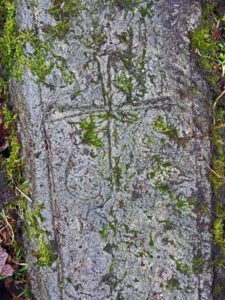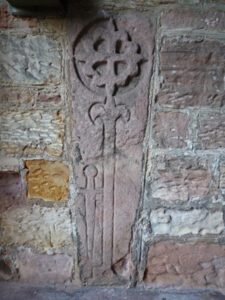Innisherrich is a tiny island, which can be reached by a causeway at low tide from Portinnisherrich on the south shore of Loch Awe. Its name means Isle of the Foals and tradition has it that it has always been a sacred island and was a pre-Christian burial place.

The reputation of Innisherrich as a very ancient sacred place may well have some merit. Not far from the southern limit of the loch is the Kilmartin valley, famous for its profusion of prehistoric monuments including royal burial cairns, the stone circle of Temple Wood (where an archer was once buried in the centre) and standing stone alignments. On a rocky crag at the southern end of valley stands the hill of Dunadd, once a place where kings were inaugurated and is believed to be the capital of the Gaelic kings of Dalriada. It was on its summit in the 6th century that St Columba anointed king Aedan with holy oil – the first time such a significant Christian ritual was ever carried out involving a reigning monarch in Britain and has been maintained by Christianity to this day.
St Columba effectively inserted the Christian church between god and the king, probably supplanting a pagan role performed historically by what we now call Druids. If Innisherrich had been sacred long before St Columba arrived in the area, then perhaps that would explain why he is said to have established a sacred place not far away at Kilneuair and built a chapel. Kilneuaire in Gaelic is Cille Iubhair and means Chapel of the Yew. Although there are sadly no yews there now it implies there were in St Columba’s day and the fascinating ruins of the chapel are to be seen today next to the ruins of a much later medieval construction. Around the ruins is a recumbent Knights Templar grave slab.

Today Innisherrich consists of a rectangular churchyard enclosure, still used for burials, with a ruined 16th century chapel and gravestones with names dating to the 1700’s. Before then gravestones at Innisherrich were not normally carved with names. Following the Knights Templar being officially disbanded in the early 14th century, it is said that some seven years before, some of the Order had escaped the persecution of the Templars instigated by the French king Philippe IV in 1307. They sailed to Scotland and some took refuge in the area around Loch Awe which the churchyard of Kilneuair appears to prove. Additionally it has been claimed that grave slabs both on display and still in the churchyard at Kilmartin include some of Templar knights. However, Templar graveslabs were not as ornate as these and are typical of those carved for medieval Hebridean warriors. The grave slabs at Kilneuair show they are not ornate and as simple as they could be, however, the Templars did use a sword and stylised Tree of Life motif but nothing as flamboyant as these found at Kilmartin.

Two of these slabs exhibited in the churchyard at Kilmartin are compellingly different from the rest and one of the pair is very compelling indeed. On it are displayed rosette or ‘flower of life’ symbolism in geometric patterns. These flower of life motifs are typically found in Mediterranean and Middle Eastern spiritual symbolic art associated with Christianity, Islam and even older beliefs from Egypt, as found in the the Osireion, one the oldest temples so far found in Egypt. The name

dating from the 18th century engraved on the slab seems to have been carved probably long after the stone was made. Rededication of grave slabs was not an unusual practice.
Research by SYTHI conducted to date has failed to find any of similar design (excepting rosettes found on ancient stones in Ireland which have Islamic dedications) nor any interpretation of what the symbols collectively mean and the message they convey. However, there is a suggestion that the centres of the circles when plotted, bear a resemblance to the constellation of the Great Bear, also known as the Plough, which can be used to find the Pole Star.
The yew on Innisherrich is male with a 12 ft. (350m cm) girth last measured in 1999 and the island is still used for burials.


Intriguingly, a grave slab from the 1971 burial on Innisherrich depicts the typical Tree of Life motif found on the more ornate Templar grave slabs.
It is apparent that small branches have been cut from the yew. Whilst this may be obviously attributed to churchyard maintenance, there is also the possibility that they were cut for ritual purposes and buried with the deceased, either in the coffin or placed upon it. This burial rite involving yew ‘protecting’ the soul of the deceased long predates it becoming a Christian custom.
The girth size of the yew would suggest a probable origin coinciding with the building of the chapel over 400 years ago which would categorise this yew as ancient. Its relatively small canopy can be explained by it being in what is a typical slow growing environment for a yew, exposed to cold winds and temperatures for much of the year when the deciduous trees around it have lost their foliage.
There are not many yews living on islands in Britain in such exposed environments (see article on Inchlonaig) so that makes this yew exceptional, as well as ancient. Furthermore it is it is a sacred yew being where it is. It is fulfilling the Scottish tradition mentioned in the book Plants and People in Ancient Scotland (C. and J. Dickson, Tempus Stroud, 2000) that yews in Scottish churchyards were planted to ‘oversee’ the separation of the spirit from the body.
Whether there was a yew or yews here before the one we see now and way back in St Columba’s lifetime. we will never know. Nevertheless, it seems there were yews on the shores of Loch Awe at Kilneuair in the 6th century so perhaps Innisherrich, being a burial place, had one or more yews way back then. Be that as it may, unlike Kilnueair, this ancient sacred place of Innisherrich fortunately has an ancient yew today, maintaining the ancient custom of functioning in the mysteries of life and death ritually conducted at burial sites. Something it has witnessed here – and probably partaken in – for over 400 years.